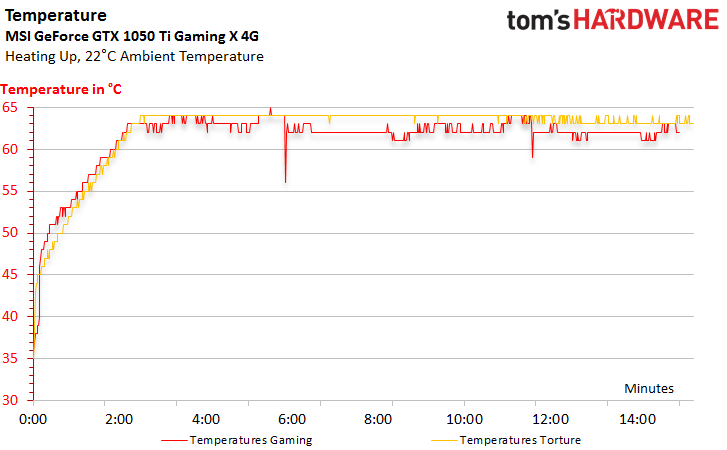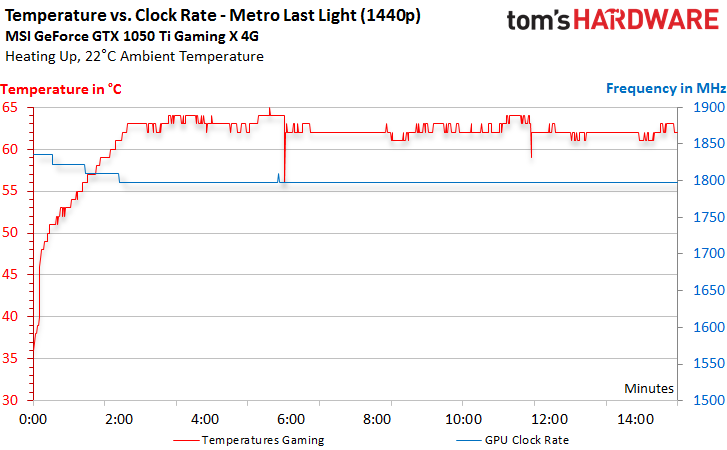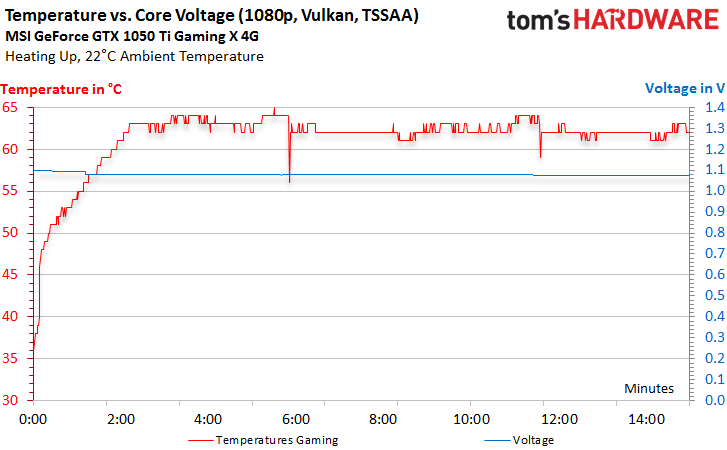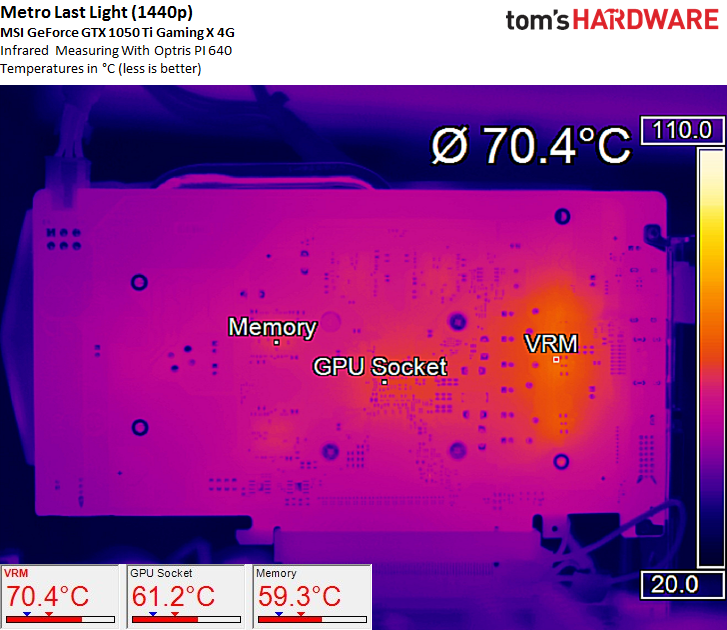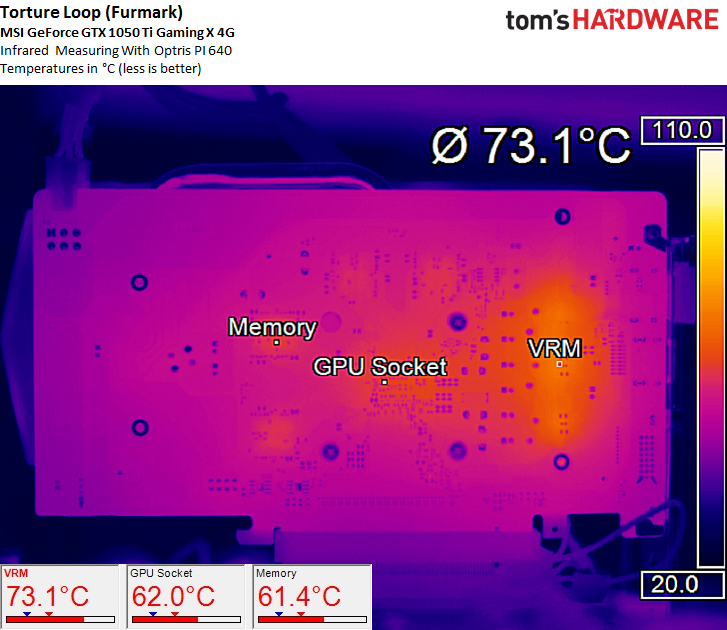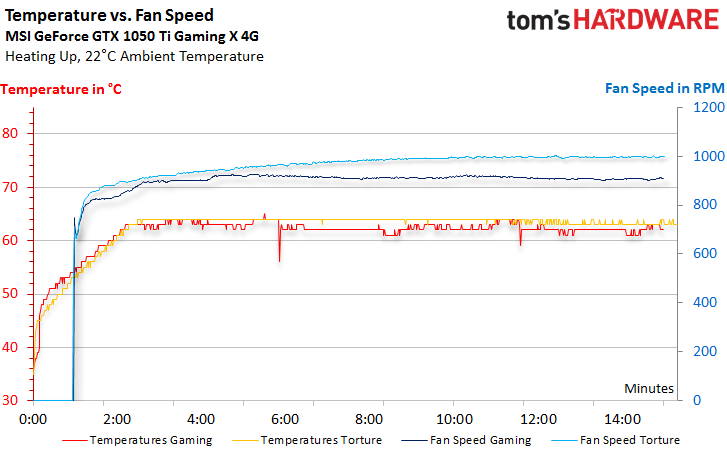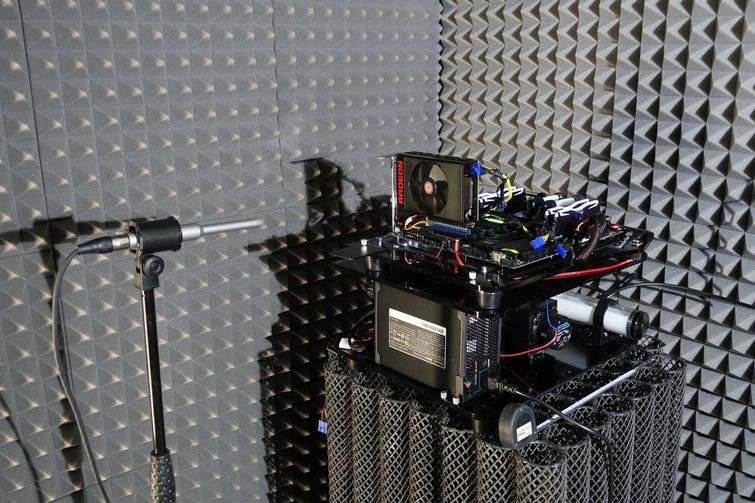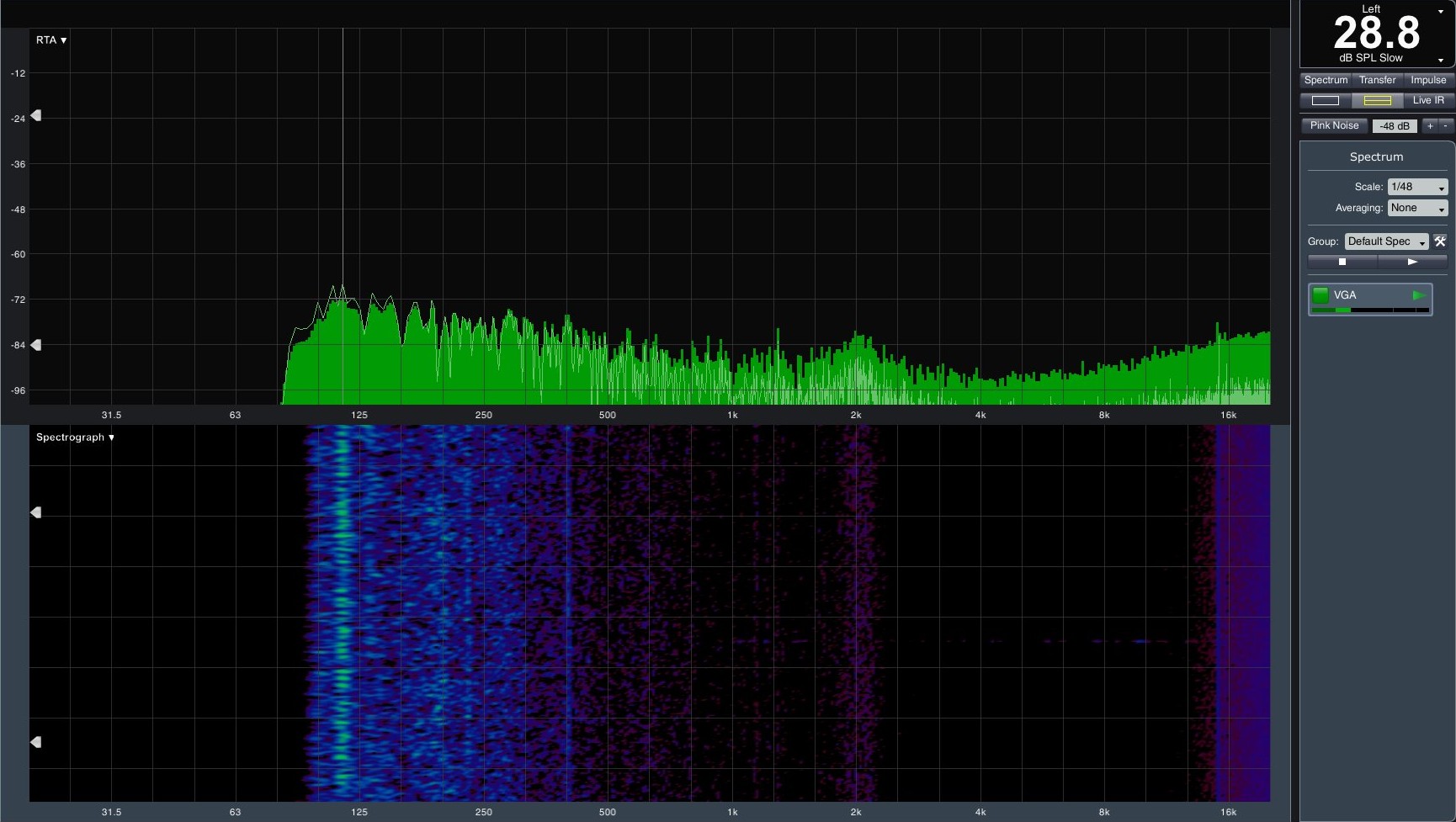Nvidia GeForce GTX 1050 & 1050 Ti Review
Frequency, Temperature & Noise Results
Influence of Temperature on Performance, GPU Boost Clock Rates & Voltages
We’ll start by examining the temperature curves that were generated during the gaming loop and stress test’s 15-minute warm-up phases. The GeForce GTX 1050 Ti Gaming X 4 GB ends up at 62 °C during the gaming loop (63 to 64 °C in a closed PC case), and 64 °C during the stress test (66 °C in a closed PC case). Those are good results.
The curve seemingly cuts off somewhere around 62 to 64 °C. This is primarily attributable to MSI’s default temperature target of 64 °C.
The observed GPU Boost clock rate starts out at a surprisingly high 1835 MHz, but then drops by approximately 40 MHz as the GeForce GTX 1050 Ti Gaming X 4 GB warms up. This difference is barely noticeable when it comes to performance, and can safely be ignored.
We set the fans to a more aggressive profile during our overclocking efforts, hoping to push MSI's card below 50 °C and eliminate thermal throttling. Again, the highest stable overclock we achieved was 1911 MHz, regardless of whether the power target was set to 110 or 125 percent.
The voltage results follow suit. An initial 1.1 V falls to 1.075 V as the card warms up, which is exactly what we'd expect based on the lower GPU Boost clock rate. This means that GP107 operates at a higher voltage than the GP106 GPU used in Nvidia’s GeForce GTX 1060 (we measured a maximum voltage of 1.062 V for that one). It’s interesting to see Nvidia allowing somewhat higher voltages to hit their performance targets; remember that GP107 comes from a different foundry and is manufactured using a 14 nm process.
Temperatures
Our infrared picture shows that the temperature under the GPU's package is in line with the processor's internal sensor.
The voltage regulators and memory modules stay well within a safe range, thermally. The temperature right underneath the memory modules reaches just 60 °C, which is a far cry from their 85 °C maximum. At 70 °C, the voltage regulators are practically cold.
Get Tom's Hardware's best news and in-depth reviews, straight to your inbox.
During our stress test, the area around the five GPU voltage regulators hits 73 °C. The hottest memory module tops out just under 62 °C. It's safe to say there's nothing wrong with MSI's cooling solution.
Fan Curves & Noise
The two large fans turn at roughly 900 RPM during the gaming loop and 1000 RPM during the stress test. This is practically inaudible from 50 cm away. Nearer to the card, the fans are more likely to be felt than heard. Ultimately, almost any other active component in your PC will be louder than MSI's GeForce GTX 1050 Ti Gaming X 4 GB.
As usual, the noise measurements are performed using our water-cooled PC in our sound-dampened anechoic chamber built for just this purpose. The setup's practical lower limit is 22 dB(A) due to the measurement system's hardware.
We actually need this low measurable noise level for once. The GeForce GTX 1050 Ti Gaming X 4 GB barely makes any noise, and it would certainly not be loud enough to get clean readings using regular measurement equipment. Levels under 30 dB(A) in a normal environment can’t be distinguished anyway.
For more information, check out Measurement Science: Taking Accurate IR Thermal Readings.
| Test System And Equipment | |
|---|---|
| Microphone | NTI Audio M2211 (with Calibration File, Low Cut at 50 Hz) |
| Amplifier | Steinberg UR12 (with Phantom Power for Microphones) |
| System | Graphics Card Test System with Optimized Water Cooling - Intel Core i7-5930K @ 4.2 GHz, Water-Cooled - Crucial Ballistix Sport, 4x 4 GB DDR4-2400 - MSI X99S XPower AC - 1x Crucial MX200, 500 GB SSD (System) - 1x Corsair Force LS, 960 GB SSD (Applications, Data) - be quiet! Dark Power Pro, 850 W Power Supply Unit (PSU) |
| Water Cooling | - Alphacool VPP655 Pump (Undervolted) - Alphacool NexXxos CPU Cooler - Phobya Balancer - Alphacool 24 cm Radiator - 2x 12 cm Noiseblocker eLoop Fan @ 400 RPM |
| Software | Smaart v.7 |
| Measurement Chamber | Custom-Made Proprietary Measurement Chamber, 3.5 x 1.8 x 2.2 m (L x D x H) |
| Measurement Position | Perpendicular to Center of Noise Source(s), Measurement Distance of 50 cm |
| Measurement Data | - Noise Level in dB(A) (Slow), Real-time Frequency Analyzer (RTA) - Graphical Frequency Spectrum of Noise |
The fans don’t spin when the card is idle, so we're skipping that result. During gaming, we end up with a reading of 28.8 dB(A), which is even lower than MSI's GeForce GTX 1060 Gaming X 3G’s 29.3 dB(A). Across the frequency spectrum, the card peaks on the low end. This noise originates from the bearings. The actual fan noise is drowned out by the card’s overall quiet whisper and ambient noise.
Combined with our temperature results, we can safely conclude that the cooler is large to the point of being oversized. MSI clearly doesn't need such a beefy solution.
MORE: Best Graphics Cards
MORE: Desktop GPU Performance Hierarchy Table
MORE: All Graphics Content
Current page: Frequency, Temperature & Noise Results
Prev Page Power Consumption Results Next Page Conclusion-
WildCard999 EVGA GTX 1050 ti around $150Reply
http://www.evga.com/Products/ProductList.aspx?type=0&family=GeForce+10+Series+Family&chipset=GTX+1050+Ti
EVGA GTX 1050 around $120
http://www.evga.com/Products/ProductList.aspx?type=0&family=GeForce+10+Series+Family&chipset=GTX+1050
It will probably be about $20-$30 more for the SSC & FTW versions. -
elbert Leaks suggested the 1050ti is as fast as the 960 and R9 280. I would love to have seen if that was true. My 280 is getting old and needs an upgrade. Any chance those can be added to the benchmarks?Reply -
tslot05qsljgo9ed Blind TrollReply
Zortac GTX 1050 Mini: $109.95
Zortac GTX 1050 Ti Mini: $139.95
http://www.newegg.com/Product/ProductList.aspx?Submit=ENE&IsNodeId=1&Description=1050&bop=And&SrchInDesc=zotac&Page=1&PageSize=36&order=BESTMATCH -
Corwin65 Reply18776894 said:Blind Troll
Zortac GTX 1050 Mini: $109.95
Zortac GTX 1050 Ti Mini: $139.95
http://www.newegg.com/Product/ProductList.aspx?Submit=ENE&IsNodeId=1&Description=1050&bop=And&SrchInDesc=zotac&Page=1&PageSize=36&order=BESTMATCH
If you're in the market snag one of those before prices jump. -
cdrkf @Elbert no way the 1050ti is going to best the 280, it's just not got enough resources behind it.Reply
You'd be far better looking at an RX 470 / 480 card or one of the 1060 cards imo. The only advantage to the 1050ti over your current card is lower power consumption, although the 280 isn't that bad anyhow. -
artk2219 All I am seeing is a nice pricewar brewing for the midrange segment. The RX 460 needs to drop to 90 to 95. and the 470 should ideally drop to 150 to 160. On Nvidias end the 1050 is just fine at 110, but the ti needs to drop to 130 to 135. Either way, i would save a little more and take a used R9 290 over any of them, but thats me. The only real reason to be crazy excited about the 1050, is if your limited to a single slot case and need a low power but decent performance card. In which case the 1050's are an excellent option, we really could use a nice single slot card.Reply -
spdragoo @Elbert: Didn't find direct comparisons to the R9 280, but Techspot's review showed benchmark comparisons to the R9 380 (which is pretty much on par with the 280):Reply
http://www.techspot.com/review/1269-nvidia-geforce-gtx-1050/
@CDRKF: Technically, you're correct: the GTX 1050Ti didn't (consistently) put in a better performance than the GTX 960 or R9 380. However, there were a couple of games that it beat them in (beating the 960 more often than the 380), & even when it didn't beat them its performance was right in the ballpark. To me, that says that either the 1050 or 1050Ti would make an excellent card for someone wanting to replace a broken R9 280/280 or GTX 960, but doesn't have the budget for a GTX 1060 or RX 470/480, & especially a good choice for someone whose system (*cough* OEM garbage *cough*) doesn't allow them to use a GPU that requires PCIe power connectors...as long as they're not expecting to game any higher than 1080p resolutions.
